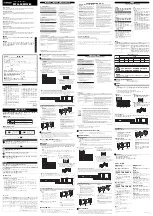30085798
FIGURE 1. Ideal CCM Regulator Inductor Current i
L
(t)
CURRENT REGULATORS
Current regulators can be designed to accomplish three basic
functions: buck, boost, and buck-boost. All three topologies
in their most basic form contain a main switching MosFET, a
recirculating diode, an inductor and capacitors. The LM3424
is designed to drive a ground referenced NFET which is per-
fect for a standard boost regulator. Buck and buck-boost
regulators, on the other hand, usually have a high-side switch.
When driving an LED load, a ground referenced load is often
not necessary, therefore a ground referenced switch can be
used to drive a floating load instead. The LM3424 can then
be used to drive all three basic topologies as shown in the
Basic Topology Schematics section. Other topologies such
as the SEPIC and flyback converter (both derivatives of the
buck-boost) can be implemented as well.
Looking at the buck-boost design, the basic operation of a
current regulator can be analyzed. During the time that the
NFET (Q1) is turned on (t
ON
), the input voltage source stores
energy in the inductor (L1) while the output capacitor (C
O
)
provides energy to the LED load. When Q1 is turned off
(t
OFF
), the re-circulating diode (D1) becomes forward biased
and L1 provides energy to both C
O
and the LED load.
L
(t)) waveform for a regulator
operating in CCM.
The average output LED current (I
LED
) is proportional to the
average inductor current (I
L
) , therefore if I
L
is tightly con-
trolled, I
LED
will be well regulated. As the system changes
input voltage or output voltage, the ideal duty cycle (D) is var-
ied to regulate I
L
and ultimately I
LED
. For any current regulator,
D is a function of the conversion ratio:
Buck
Boost
Buck-boost
PEAK CURRENT MODE CONTROL
Peak current mode control is used by the LM3424 to regulate
the average LED current through an array of HBLEDs. This
method of control uses a series resistor in the LED path to
sense LED current and can use either a series resistor in the
MosFET path or the MosFET R
DS-ON
for both cycle-by-cycle
current limit and input voltage feed forward. The controller has
a fixed switching frequency set by an internal programmable
oscillator which means current mode instability can occur at
duty cycles higher than 50%. To mitigate this standard prob-
lem, an aritifical ramp is added to the control signal internally.
The slope of this ramp is programmable to allow for a wider
range of component choices for a given design. A detailed
explanation of this control method is presented in the follow-
ing sections.
SWITCHING FREQUENCY
The switching frequency of the LM3424 is programmed using
an external resistor (R
T
) connected from the RT pin to GND
as shown in
Alternatively, an external PWM signal can be applied to the
RT pin through a filter (R
FLT
and C
FLT
) and an AC coupling
capacitor (C
AC
) to synchronize the part to an external clock
. If the external PWM signal is applied at
a frequency higher than the base frequency set by the R
T
re-
sistor, the internal oscillator is bypassed and the switching
frequency becomes the synchronized frequency. The exter-
nal synchronization signal should have a pulse width of
100ns, an amplitude between 3V and 6V, and be AC coupled
to the RT pin with a ceramic capacitor (C
AC
= 100pF). A
10MHz RC filter (R
FLT
= 150Ω
and C
FLT
= 100 pF) should be
placed between the PWM signal and C
AC
to eliminate un-
wanted high frequency noise from coupling into the RT pin.
The switching frequency is defined:
See the Typical Performance Characteristics section for a plot
of R
T
vs. f
SW
.
www.national.com
10
LM3424


















